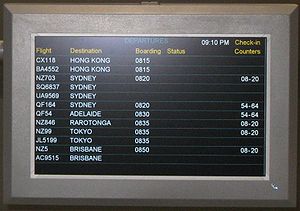
- Image via Wikipedia
As part of regulations unveiled today that were advertised as groundbreaking rules to protect passengers in the event of tarmac delays, a second, in our opinion, more significant portion of regulation has been unveiled. Airlines will now be required to adopt a Customer Service Plan. Airlines have been required to submit plans to the DOT before, but not quite at this level. These plans, which will apply to all airlines, must be audited by each airline for compliance.
The plan must cover the following subjects:
- Offering the Lowest Fare Available
- Notifying consumers of known delays, cancellations, and diversions
- Delivering baggage on time
- Allowing reservations to be held without payment or cancelled without penalty for a defined amount of time
- Providing prompt ticket refunds
- Properly accommodating passengers with disabilities and other special-needs, including during tarmac delays
- Meeting customers’ essential needs during lengthy tarmac delays
- Handling “bumped†passengers with fairness and consistency in the case of oversales
- Disclosing travel itinerary, cancellation policies, frequent flyer rules, and aircraft configuration
- Ensuring good customer service from code-share partners;
- Ensuring responsiveness to customer complaints
- Identifying the services it provides to mitigate passenger inconveniences resulting from cancellations and misconnects
All these sound like very good things we shouldn’t have to regulate airlines in order to do. We emphasize that. We shouldn’t have to…but apparently we have to because they aren’t regulating themselves. Airline disclosure should be in their own best interests. After all, if an airline’s policies are written on their website, they can very clearly put the ball back in the passenger’s court if they fail to read them…
Let us try to describe the above in an example. Passenger buys a ticket that is changeable for a $150 penalty plus any difference in fare(we won’t debate whether or not $150 is a sane amount to pay to change a ticket, that is a whole other discussion). Passenger wants to change, decides the costs are ridiculous. Airline replies…”Didn’t you click that little box on our website that said you read our policies and agreed to them? No? Well, we disclosed them to you as per our obligation. We even made you say you read them.” That is a good example of clear disclosure. Make the language available, clear, and easy to find so that all passengers know what they are getting into and how an airline is supposed to handle certain circumstances.
To make this clear, it is not obligating the airline to give you what you want…only making them define what they will do under specific circumstances. A little clarity is worth a lot.
There may be more coming, however, as the DOT will shortly commence a new rulemaking proceeding addressing possible further enhancements to airline passenger protection in which it may consider, among other things, whether the voluntary incorporation of contingency plan terms will
result in sufficient protection for air travelers. They are of the opinion that carriers should voluntarily include their contingency plan and customer service plan into their contract of carriage and will report which airlines fail to do tis.
![Reblog this post [with Zemanta]](http://img.zemanta.com/reblog_e.png?x-id=7e455c40-661c-491c-9a45-e8dd68b77c6d)